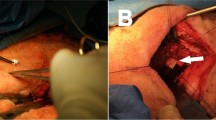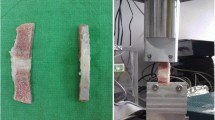Abstract
The objective of the study was to investigate the regeneration of intervertebral discs after laser discectomy using tissue engineering procedures. Annulus fibrosus (AF) cells from the intervertebral discs of Japanese white rabbits were cultured in an atelocollagen honeycomb-shaped scaffold with a membrane seal (ACHMS scaffold), to produce a high-density, three-dimensional culture for up to 3 weeks. Although the DNA content in the scaffold increased at a lower rate than that in the monolayer culture, expression of type ll collagen and glycosaminoglycan accumulation in the scaffold were at higher levels than in the monolayer. The AF cells that had been cultured in the scaffold for 7 days were allografted into the lacunae of intervertebral discs of recipients (40 rabbits, 14–16 weeks old; average weight, 3.2kg), whose nucleus pulposus (NP) had been vaporised with an ICG dye-enhanced laser. The allografted cultured AF cells survived and produced hyaline-like cartilage. Furthermore, the narrowing of the intervertebral disc space of the cell-containing scaffold insertion groups was significantly inhibited after 12 post-operative weeks.
Similar content being viewed by others
References
Bradner, M. E. (1972): ‘Normal values of the vertebral body and intervertebral disc index in adults’,Am. J. Rentgenol. Radium Ther. Nucl. Med.,114, pp. 411–414
Burgeson, R. E., andHollister, D. W. (1979): ‘Collagen heterogeneity in human cartilage: identification of several new collagen chains’,B B R C,87, pp. 1124–1131
Chiba, K., Anderson, G. B. J., Masuda, K., andThonar, E. J. (1997): ‘Metabolism of the extracellular matrix formed by intervertebral disc cells cultured in alginate’,Spine,22, pp. 2885–2893
Farndale, R. W., Buttle, A. J., andBarrett, A. J. (1986): ‘Improved quantitation and discrimination of sulphated glycosaminoglycans by use of dimethylmethylene blue’,Biochem. Biophys. Acta,883, pp. 173–177
Frenkel, S. R., Toolan, B., Menche, D., Pitman, M. I., andPachence, J. M. (1997): ‘Chondrocyte transplantation using collagen bilayer matrix for cartilage repair’,J. Bone Joint Surg.,79-B, pp. 831–836
Gan, J. C., Ducheyne, P., Vresilovic, E., andShapiro, I. M. (2000): ‘Bioactive glass serves as a substrate for maintenance of phenotype of nucleus pulposus cells of intervertebral disc’,J. Biomed. Mater. Res.,51, pp. 596–604
Gruber, H. E., Fisher, E. C., Desai, B., Stasky, A. A., Hoelscher, G., andHanley, E. N. (1997): ‘Human intervertebral disc cells from the annulus: three-dimensional culture in agarose or alginate and responsiveness to TGF-β1’,Exp. Cell Res.,235, pp. 13–21
Itoh, H., Aso, Y., Furuse, M., Noishiki, Y., andMiyata, T. (2001): ‘A honeycomb collagen carrier for cell culture as a tissue engineering scaffold’,Artif. Organs,25, pp. 231–237
Kim, Y. J., Sah, R. L., Doong, J. Y., andGrodzinsky, A. J. (1988): ‘Fluorometric assay of DNA in cartilage explants using Hoechst 33258’,Anal. Biochem.,174, pp. 168–176
Kumagai, J., Sarkar, K., Uhthoff, H. K., Okawara, Y., andOoshima, A. (1994): ‘Immunohistochemical distribution of type I, II, and III collagens in the rabbit supraspinatus tendon insertion’,J. Anat.,185, pp. 279–284
Loty, S., Sautier, J-M., Loty, C., Boulekbache, H., andKokubo, T. (1998): ‘Cartilage formation by fetal rat chondrocytes cultured in alginate beads: a proposed model for investigating tissue-biomaterial interactions’,J. Biomed. Mater. Res.,42, pp. 213–222
Mochida, J., Nishimura, K., Nomura, T., Toh, E., andChiba, M. (1996): ‘The importance of preserving disc structure in surgical approaches to lumbar disc hemiation’,Spine,21, pp. 1556–1563
Nishida, K., Kang, J. D., Suh, J. K., Robbins, P. D., Evans, C. H., andGilbertson, L. G. (1998): ‘Adenovirus-mediated gene transfer to nucleus pulposus cell: implications for the treatment of intervertebral disc degeneration’,Spine,23, pp. 2437–2442
Nishimura, K., andMochida, J. (1998): ‘Percutaneous reinsertion of nucleus pulposus: an experimental study’,Spine,23, pp. 1531–1539
Ochi, M., Uchio, Y., Tobita, M., andKuriwaka, M. (2001): ‘Current concepts in tissue engineering technique for repair of cartilage defect’,Artif. Organs,25, pp. 172–179
Okuma, M., Mochida, J., Nishimura, K., Sakabe, K., andSeiki, K. (2000): ‘Reinsertion of stimulated nucleus pulposus cells retards intervertebral disc degeneration: anin vitro andin vivo experimental study’,J. Orthop. Res.,18, pp. 988–997
Peterson, L., Minas, T., Brittberg, M., Nilsson, A., Sjogren-Jansson, E., andLindahl, A. (2000): ‘Two- to 9-year outcome after autologous chondrocyte transplantation of the knee’,Clin. Orthop.,374, pp. 212–234
Poiraudeau, S., Monteiro, I., Anract, P., Blanchard, O., Revel, M., andCorvol, T. (1999): ‘Phenotypic characteristics of rabbit intervertebral disc cells: comparison with cartilage cells from the same animals’,Spine,24, pp. 837–844
Sato, M., Ishihara, M., Arai, T., Asazuma, T., Kikuchi, T., Hayashi, T., Yamada, T., Kikuchi, M., andFujikawa, K. (2001a): ‘Use of a new ICG-dye-enhanced diode laser for percutaneous laser disc decompression’,Lasers Surg. Med.,29, pp. 282–287
Sato, M., Kikuchi, T., Asazuma, T., Yamada, H., Maeda, H., andFujikawa, K. (2001b): ‘Glycosaminoglycan accumulation in primary culture of rabbit intervertebral disc cells’,Spine,26, pp. 2653–2660
Sato, M., Asazuma, T., Ishihara, M., Kikuchi, T., Masuoka, K., Ichimura, S., Kikuchi, M., Kurita, A., andFujikawa, K. (2003): ‘An atelocollagen honeycomb-shaped scaffold with a membrane seal (ACHMS-scaffold) for the culture of annulus fibrosus cells from an intervertebral disc’,J. Biomed. Mater. Res.,64A, pp. 248–256
Sumida, K., Sato, K., Aoki, M., Matsuyama, Y., andIwata, H. (1999): ‘Serial changes in the rate of proteoglycan synthesis after chemonucleolysis of rabbit intervertebral discs’,Spine,24, pp. 1066–1070
Author information
Authors and Affiliations
Corresponding author
Rights and permissions
About this article
Cite this article
Sato, M., Kikuchi, M., Ishihara, M. et al. Tissue engineering of the intervertebral disc with cultured annulus fibrosus cells using atelocollagen honeycombshaped scaffold with a membrane seal (ACHMS scaffold). Med. Biol. Eng. Comput. 41, 365–371 (2003). https://doi.org/10.1007/BF02348444
Received:
Accepted:
Issue Date:
DOI: https://doi.org/10.1007/BF02348444




